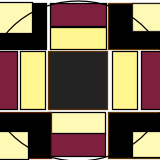Paul, Brian and Miles
Leo explained more about the thicknesser.
The table is suspended from the top on two large screws and is raised and lowered on these. As wood enters and the first roller hits it, it actually tilts the table slightly, ths causing the snipe until the outfeed roller is encountered. If a stick of wood is jammed under the table (eg for the final planing cut) it prevents the tilt and snipe. Leo’s planer has two rollers on top and two underneath. The smaller ones have just the two top rollers.
He then went over the glue-up.
For the top and bottom slabs, he first glues up the thinner slats by placing them all together and clamping them (without putting glue on the center between each three mating pieces). This way it is a solider thing for the clamping process. A small dab of glue can be placed at the very ends of the center pieces to keep it from slipping. The ends are cut off once the glue dries. Once these are dry, he glues on the end blocks, keeping everything flat. Once dry you can scrape off the surfaces but you can’t plane any off.
Tip:
If you have several pieces glued and the bottom is uneven, a flat piece can be glued to the underside center with a dab of glue and then the piece is run through the thicknesser to plane off the top section. Flipping it over it finishes the job.
 |
| Vase project Photos |
No comments:
Post a Comment